Abstract
This paper presents a comprehensive evaluation of the previously introduced multidisciplinary model to quantify human uncertainty (MMtQHU) within a realistic 5G-enabled cyber–physical–social systems (CPSS) environment. The MMtQHU, which integrates human, social, and environmental factors into CPSS modeling, is applied to the Ingolstadt traffic scenario (InTAS), a detailed urban simulation reflecting high-traffic conditions. By modeling unpredictable driver behaviors, such as deviations from optimal routes, the study assesses the model’s effectiveness in managing human-induced uncertainties in vehicle-for-hire (VFH) applications. The evaluation shows that human uncertainty significantly impacts 5G network resource allocation and traffic dynamics. A comparative analysis of traditional resource allocation methods reveals their limitations in handling the dynamic nature of human behavior. These findings underscore the necessity for advanced, adaptive strategies, potentially leveraging artificial intelligence and machine learning to enhance the resilience and efficiency of 5G networks in CPSS environments. The study offers valuable insights for future advancements in robust and adaptive 5G infrastructure by highlighting the critical role of integrating human behavior into CPSS models.
1. Introduction
Cyber–physical–social systems (CPSS) represent a significant advancement over traditional cyber–physical systems by integrating physical and digital components with human interactions and social dynamics. These systems have become increasingly critical for addressing complex challenges across various domains, i.e., challenges that conventional approaches are often ill-equipped to manage effectively [1,2,3]. The integration of the social dimension, however, introduces significant uncertainty, as human behavior is inherently variable and subjective, complicating the prediction and efficient management of resources [4,5,6].
As CPSS increasingly encompass diverse human behaviors and social interactions, it becomes evident that traditional methodologies are inadequate for managing the resulting qualitative uncertainties. This complexity underscores the need for multidisciplinary frameworks capable of addressing the dynamic interplay among cyber, physical, and social components [7,8]. Traditional approaches often prove insufficient in dealing with these uncertainties, leading to inefficiencies in service delivery, particularly in dynamic environments like 5G networks [9], where demand and network conditions fluctuate rapidly. Such constraints not only reduce system efficiency but also compromise the quality of service in critical applications, including real-time resource allocation in densely populated urban areas.
Furthermore, the inability to accurately predict human behavior in highly variable situations can result in either underutilization or overload of network resources, adversely affecting user experience. This issue is particularly acute in applications like autonomous vehicles, where unexpected driver behaviors can destabilize the network and create bottlenecks [10]. Additionally, the lack of integration of specific, representative data in current models limits systems’ ability to adapt to the unique characteristics of different urban environments, hindering effective resource management strategies in complex, dynamic scenarios [11,12].
To address these limitations, recent research has developed multidisciplinary frameworks aimed at better integrating human behavior into CPSS modeling [13,14]. These frameworks acknowledge the complex interactions among cyber, physical, and social components, emphasizing the need for CPSS to evolve adaptively in response to dynamic changes [15]. Nonetheless, managing uncertainty within these systems remains a central challenge, particularly in ensuring the reliability and validity of decisions made under uncertain conditions.
This study extends our previous work that introduced a model aimed at quantifying human uncertainty in human-centric CPSS. Now formally designated as the multidisciplinary model to quantify human uncertainty (MMtQHU), this model integrates a broad spectrum of contextual factors into a situational analysis to enhance the adaptability and overall performance of CPSS in the presence of unpredictable human behavior [16].
The MMtQHU is a conceptual framework designed to quantify and manage the uncertainty generated by human behavior in CPSS. Human actions, often unpredictable and influenced by a variety of social, personal, and environmental factors, introduce qualitative uncertainty that can significantly affect the performance of technological systems. The model operates by incorporating three main contextual layers:
- Natural Context: Accounts for environmental factors such as time and location, which can influence both individual and collective behaviors.
- Social Context: Includes institutional, organizational, and social network influences, recognizing that people’s decisions are shaped by their social environments and interactions with others.
- Personal Context: Focuses on personal data and characteristics, including personality traits and information collected through technological devices, which affect individual decision-making processes.
By dynamically integrating these layers, the MMtQHU provides a comprehensive approach to modeling human uncertainty. It stands out for its adaptability, allowing the model to be applied to various real-world scenarios, such as 5G network management and autonomous vehicle deployment. Structuring the model around boundary objects (BOs) facilitates interdisciplinary collaboration, enabling stakeholders from different fields, such as engineering, social sciences, and urban planning, to understand and work together on complex problems. BOs serve as shared references that maintain consistency across disciplines while allowing for the flexibility needed to incorporate domain-specific knowledge.
Building upon the MMtQHU framework, this study aims to achieve three main objectives: (i) to evaluate the conceptual human uncertainty model using a more robust dataset specific to Ingolstadt; (ii) to identify how drivers’ reactions to various urban characteristics, considered as factors of human uncertainty, affect resource allocation in 5G networks; (iii) to identify possible methods to enhance human uncertainty management in CPSS through the integration of detailed urban data and advanced simulation techniques.
The remainder of the paper is structured as follows: Section 2 reviews the related works, providing an overview of existing literature on uncertainty modeling in CPSS and highlighting the gaps addressed by this study. Section 3 establishes the conceptual framework of the research. Section 4 provides a detailed explanation of the simulation framework parameters, including the configurations and methodology employed. Section 5 offers an in-depth discussion of the simulation framework, presenting the configurations and methodology. The results are presented in Section 6, followed by a thorough discussion of their implications in Section 7. Finally, Section 8 concludes the paper with a summary of the key findings and recommendations for future research directions.
2. Related Works
Uncertainty modeling is a critical aspect of CPSS, particularly when human factors introduce variability that complicates prediction and resource management. Traditional methodologies often fall short in handling these qualitative uncertainties, leading to inefficiencies in dynamic environments such as 5G networks [17,18]. This section organizes and reviews existing literature, highlighting their methodologies, results, and limitations while positioning how this study advances the field.
2.1. Uncertainty in Engineering Models
In engineering, uncertainty modeling has been approached from various theoretical perspectives. For instance, in [18], a mathematical framework is proposed that focuses on variables with uncertain values in complex systems. This study presents foundational techniques, yet it lacks practical applications in dynamic, human-centric systems like CPSS. Similarly, in [19], the authors introduce uncertainty theory to model human factors; however, this work remains largely theoretical and does not demonstrate its applicability in operational systems.
Building on these foundational perspectives, in [20], the authors classify different types of uncertainties within engineering models, offering general guidelines for their management. While this work provides a broad categorization of uncertainties, more specific applications can be seen in [21], where uncertainty modeling is applied to stress prediction. Nevertheless, the focus in this case remains confined to technical variables without adequately addressing human variability.
To extend this line of inquiry, in [22], the authors present a patented method for incorporating human error into engineering design by adjusting the design load to account for the potential loss of resisting force due to human error. However, despite this advancement, the patent does not offer a holistic model capable of quantifying the effects of human uncertainty in dynamic systems such as CPSS. Collectively, these studies contribute valuable insights into uncertainty from a technical and theoretical perspective. Yet, they fall short of presenting comprehensive frameworks that effectively manage human uncertainty, which is increasingly recognized as a critical factor in the design and operation of CPSS.
2.2. Human Uncertainty and Behavior in Communication Networks
The context of communication networks introduces distinct challenges for uncertainty modeling, particularly when human factors influence network performance and resource allocation. A contribution in this area is presented in [17], where the authors focus on stochastic uncertainty in 5G networks and propose a robust optimization framework for resource allocation. Despite the technical sophistication of this work, it primarily addresses uncertainties related to fluctuating user demands without considering the unpredictable nature of human behavior, which limits its application in CPSS.
Expanding on this, in [23], the authors explore network slicing in 5G systems and propose an admission control and resource reservation mechanism designed to ensure robustness against uncertainties such as the number of slice users and their unpredictable locations. Although this methodology improves resource management through over-reservation strategies, it fails to account for human uncertainties, particularly the variability in user behavior, which is essential in CPSS environments.
Similarly, in [24] the authors address resource allocation optimization in cloud computing, where user demand fluctuates unpredictably. The authors propose a hybrid method combining reserved and on-demand resource allocation to ensure quality of service (QoS). However, this approach remains confined to cloud environments and does not extend to CPSS, where the influence of human factors plays a more significant role.
Additionally, [25] examines resource allocation in network slicing for mobile networks, focusing on uncertainties related to the number of users and their resource consumption. While this study provides valuable insights into managing technical uncertainty, it similarly overlooks human variability, which is critical for CPSS. Moreover, in [26], the authors propose a stochastic model for video delivery networks, optimizing both energy efficiency and QoS. Although effective within the domain of video delivery, this approach is content-specific and lacks the flexibility needed to generalize it to other CPSS applications where human behavior could have a greater impact.
2.3. Human-Centric Uncertainty in System Design
Several studies have addressed the role of human behavior and its associated uncertainty in system performance. For instance, in [27], the authors investigate handovers in radio access networks (RAN) utilizing network slicing technology and propose a learning-based handover scheme known as LESS. This approach manages uncertainty by adapting to changing network conditions; however, it does not consider human decision-making as a critical factor influencing system performance.
Similarly, in [28], the authors introduce a generalized dual descent method to simplify online resource allocation under uncertain time horizons. Although this method is effective in handling technical uncertainties, it lacks the flexibility required to account for human uncertainty, which is vital for the effective operation of CPSS.
In contrast, [29,30] adopt a more human-centric perspective, concentrating on linguistic uncertainty in AI models and the impact of human decision-making. These studies offer valuable insights into human reasoning and its influence on system behavior; however, they fall short in extending these findings to the quantification of uncertainty in dynamic systems such as CPSS.
From these reviewed studies, a common theme emerges: while technical uncertainties are frequently addressed through probabilistic models, human uncertainties remain significantly underexplored. On the one hand, certain studies, such as [23,24], focus on enhancing adaptability to fluctuating demands, primarily from a technical standpoint. On the other hand, works like [26,28] prioritize energy and cost efficiency. Nevertheless, all of these studies present limitations in terms of generalizability, particularly when addressing the complexity introduced by human behavior. This gap is especially evident in CPSS, where dynamic and unpredictable human factors play a crucial role in system performance. The key comparisons between these studies are summarized in Table 1.

Table 1.
Comparison of studies on resource management and optimization under uncertainty.
This study addresses critical gaps in the existing literature by presenting and evaluating the MMtQHU model, a framework that quantitatively integrates technical, environmental, social, and human behavioral factors in a realistic setting. Unlike previous research that focuses exclusively on technical uncertainties or analyzes human factors qualitatively without rigorous quantification, the MMtQHU model provides a comprehensive and robust approach. By modeling the unpredictable nature of human behavior along with traditional technical factors, the MMtQHU model overcomes the limitations of previous models, which tend to ignore human variability or fail to provide a robust methodology for managing its impact on dynamic systems such as CPSS.
In this study, the MMtQHU model is specifically applied to a vehicle-for-hire (VFH) scenario within a 5G network slice, where drivers’ behavioral responses to urban environmental factors directly affect network resource allocation. Using detailed urban data from the Ingolstadt traffic scenario and advanced simulation techniques, the study provides a practical assessment of how human variability influences network performance. This approach represents an advance over previous models, which have focused primarily on managing technical uncertainties without fully considering the unpredictable nature of human behavior.
3. Model to Quantify Human Uncertainty in Human-Centric Cyber–Physical–Social Systems
The MMtQHU model was originally introduced in our prior work [16]. To enhance the clarity and flow of this paper, some key details from that publication are reiterated here. However, the complete and comprehensive description of the model, including its foundational principles, can be found in the original work.
The MMtQHU model presents a layered framework designed to integrate a range of factors influencing decision-making processes within dynamic environments, particularly in CPSS. The model is organized into three core layers: natural context, social context, and personal context, each contributing to a comprehensive assessment of human uncertainty, as depicted in Figure 1. This human-centric approach enhances the model’s adaptability, making it suitable for both current and future applications.
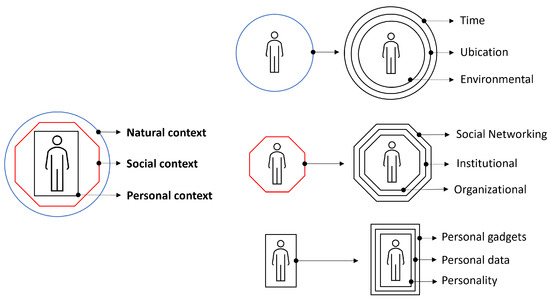
Figure 1.
MMtQHU model (from [16]).
The natural context layer includes environmental and situational factors, such as weather conditions, time of day, and traffic density, which are critical variables in urban CPSS environments. The social context layer examines societal norms, peer behaviors, and community expectations, leveraging probabilistic modeling to capture the inherent variability in human social dynamics. Finally, the personal context layer focuses on individual traits, preferences, and cognitive biases modeled using data from psychological assessments and personal histories. These layers work together to simulate varying levels of risk tolerance, decision-making speed, and adaptability, which are crucial for managing broader systemic uncertainties within CPSS.
To illustrate the practical application of the MMtQHU model, a use case involving a VFH application operating within a 5G network slice is analyzed. VFH apps, such as Uber and InDriver, connect users requiring mobility with drivers offering vehicles in real-time. The process begins when a user selects a starting point and a destination, generating a route for the driver to follow after accepting the service. Ensuring the quality of service on these routes requires the availability of network resources, including the frequencies needed for handovers during the trip. However, the absence of penalties for drivers who deviate from the predefined route introduces uncertainty into resource planning, as route changes may stem from drivers’ decisions to maximize profits or avoid certain areas, affecting resource allocation and network performance.
The MMtQHU model establishes a reference architecture that systematically documents and analyzes the interaction between system components, as illustrated in Figure 2. Based on this architecture, the key elements necessary for implementation have been formulated and weighted with the aim of quantifying the qualitative uncertainty associated with drivers in the context of a VFH application.
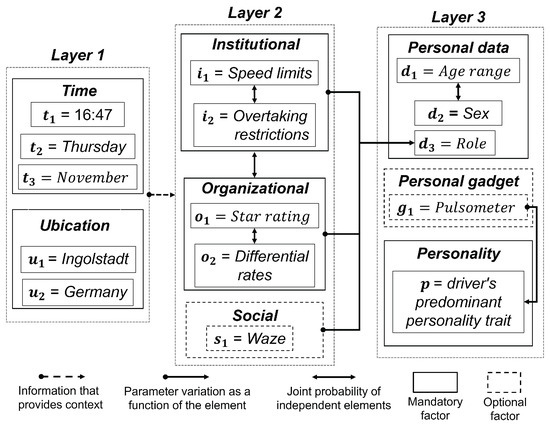
Figure 2.
Reference architecture applied to the 5G VFH use case evaluated (from [16]).
Based on the reference architecture shown in Figure 2, Equation (1) (taken from [16]) is derived, proposing an analytical model to calculate , which represents the probability that a driver chooses an alternative route instead of the one suggested by the VFH application. The value of is determined periodically for each driver, enabling an evaluation of whether a route change is necessary in each situation. These probabilities are determined based on contributions from disjoint sets of events, each reflecting a different nature.
The probability of a route change, , is determined by three primary components: psychophysiology (), demographic segment (), and role fit ().
The psychophysiology component, , captures the likelihood of a route change based on the driver’s dominant personality trait and the impact of heart rate on behavior. It is assumed that the probability of altering a predefined route is uniformly distributed across a range of values specific to each personality trait, denoted by . Additionally, the driver’s awareness of their heart rate contributes additively to this probability, represented by . Therefore, the total psychophysiological contribution is given by .
The demographic segment component, , evaluates the probability of a route change by considering the driver’s age and gender. The influence of age on this probability is inferred from the distribution of car accidents across different age groups, represented by . Similarly, the impact of gender is derived from the probability of accidents involving males and females, denoted by . These contributions are assumed to be independent, resulting in .
The role fit component, , quantifies the probability of a route change based on the driver’s role, e.g., whether they are an owner or an employee, and their response to social media information and institutional and organizational factors. The influence of social media is represented by , while the response to institutional () and organizational () factors is captured by the joint probability . Assuming independence among these factors, is defined as . Consequently, the total contribution from role fit is expressed as , or more explicitly, .
The role fit component, , quantifies the probability of a route change based on the driver’s role, i.e., whether they are an owner or an employee, and their response to social media, institutional, and organizational factors. Social media influence is captured by , representing the use of Waze as a navigation tool. Institutional factors include for speed limits and for overtaking restrictions, while organizational factors are (star ratings) and (dynamic pricing). The joint probability of these institutional and organizational factors, assuming independence, is given by . The total contribution to role fit is then expressed as , or more explicitly, .
For a detailed example of the MMtQHU model’s application, along with the complete algorithm governing its operation within the context of a VFH application, readers are referred to [16]. This reference provides a thorough step-by-step implementation, illustrating how the model effectively quantifies human uncertainty and enhances decision-making within dynamic CPSS. Additionally, it offers a comprehensive overview of the data sources and the specific values assigned to each component, ensuring a clear understanding of the model’s practical deployment.
4. Ingolstadt Traffic Scenario
The Ingolstadt traffic scenario (InTAS) is a comprehensive and highly detailed traffic simulation model, developed to accurately replicate real-world traffic conditions in Ingolstadt, Germany. This model not only includes a precise representation of the city’s road network but also incorporates essential urban elements such as buildings, bus stops, parking areas, and traffic lights, derived from official data and satellite imagery [31]. The development of InTAS involved transforming real geographical and demographic data into a simulation environment through tools like OpenStreetMap and Simulation of Urban Mobility (SUMO), allowing the model to accurately reflect the current road infrastructure and traffic management systems. Furthermore, InTAS simulates vehicle behavior and traffic demand based on data collected from actual traffic measurement points, making it a powerful tool for testing advanced vehicle-to-everything (V2X) communication technologies and optimizing traffic flow.
Originally developed for Ingolstadt, InTAS can be adapted to other cities by replicating its rigorous data collection and modeling process, thereby extending its applications in urban traffic management, public transportation, and vehicular communication systems. This adaptation requires the acquisition of local geographical and demographic data, including road networks, traffic patterns, and public transport schedules, which can be integrated into tools such as OpenStreetMap and SUMO to accurately reflect the specific urban environment.
The selection of InTAS for evaluating the MMtQHU model is based on its ability to faithfully represent the unique traffic dynamics of Ingolstadt, which are influenced by key socioeconomic and structural factors. As an industrial hub, Ingolstadt experiences significant traffic congestion due to the high volume of vehicles related to employee commutes and logistics, with Audi contributing to 43% of the local workforce. The industrial sector’s three-shift work model leads to distinct traffic peaks during shift changes, requiring urban planners to account for these variations to minimize disruptions. In addition, Ingolstadt has a higher vehicle-per-inhabitant rate than other cities, further intensifying traffic during peak hours. This is compounded by school traffic, as many parents drive their children to educational institutions. To capture these dynamics, InTAS incorporates a detailed map covering 51.54 km2 with 717 km of road length, 3342 nodes, and 7968 edges, alongside 13 public parking facilities, 56 bus lines, and 404 stops.
InTAS integrates real-world demographic and traffic data, including public transportation schedules and 98 traffic lights, 20 of which are based on actual programs while the remainder are controlled by automated systems. A key aspect of the simulation is the interaction between vehicles and the urban environment, particularly the 21,756 buildings, which impact wireless communication systems. This comprehensive simulation framework allows for an accurate representation of urban traffic, which is critical for evaluating the performance of the MMtQHU model in real-world conditions.
This study integrates these features into the MMtQHU model to create a realistic and representative case to evaluate its applicability in urban traffic environments. The main objective is to analyze how driver behavior, influenced by institutional, organizational, and psychological factors, causes deviations from predefined routes, thus modeling human uncertainty. These deviations generate variability in the allocation of resources within the 5G network, which directly affects its performance.
5. Simulation Framework and Experimental Scheme
The simulations were conducted by integrating the InTAS scenario within the Artery-C framework, selected for its advanced capability to handle both vehicular mobility and 5G communications in urban environments. Artery-C, specifically designed for vehicular communication (V2X) in 5G networks, supports real-time communication scenarios in highly dynamic environments and is compatible with the SUMO platform. SUMO was employed to manage detailed traffic simulations, renowned for accurately modeling complex urban traffic behaviors and interactions. This combination provides an optimal environment for studying the impact of human uncertainty on network resource allocation in 5G networks.
5.1. Simulation Framework
The decision to employ SUMO and Artery-C was based on their complementary strengths in simulating both the physical and network layers. SUMO provides detailed traffic flow modeling, ensuring a realistic representation of vehicular movements, while Artery-C is specifically designed to simulate vehicular communications in 5G environments, supporting V2N, V2V, and V2I communications. This dual-layer approach enables the simulation to capture both vehicular mobility and network interactions, which are critical for accurate modeling.
By combining real-time traffic data with network communication simulations, the framework provides a realistic environment for analyzing network handovers and congestion during periods of high traffic density. Additionally, this integration effectively captures the influence of human uncertainty, such as deviations from optimal routes, on both vehicular mobility and 5G network performance.
Figure 3 illustrates the integration between SUMO and Artery-C, where real-time traffic data from SUMO are processed to simulate vehicle communications with 5G infrastructure. The integration of these tools, along with frameworks like OMNeT++ and INET, creates a comprehensive simulation environment that accurately models vehicular mobility and network performance. The use of TraCI4Matlab enables real-time communication between MATLAB models and the simulation environment, ensuring dynamic evaluation of model parameters.
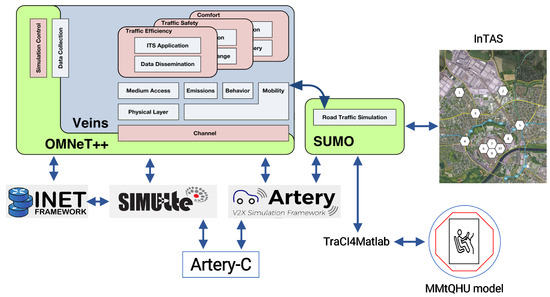
Figure 3.
Framework integration for traffic and network system simulation with the MMtQHU Model in the realistic InTAS scenario (adapted from [16]).
Framework Integration Description
Artery-C is integrated with OMNeT++ to provide a modular, component-based simulation environment. This design facilitates the development of complex models using OMNeT++’s NED language, enhancing reusability and simplifying the integration of core simulation components. Leveraging the INET framework, Artery-C simulates network devices such as hosts, routers, and switches via modular, message-based interactions.
A key aspect of this research is the integration with SUMO, which is essential for synchronizing detailed traffic data (e.g., vehicle counts and road configurations) with network simulations, providing a holistic system view. The MMtQHU model, implemented in MATLAB, is integrated using the TraCI4Matlab protocol, which bridges MATLAB and SUMO, enabling continuous injection and evaluation of model parameters throughout the simulation. This seamless connection between MATLAB, SUMO, and Artery-C is crucial for effectively applying research models in complex environments.
Alternative platforms, such as Cooja and VISSIM, were considered but ultimately dismissed due to their limitations in simulating detailed real-time V2X communications and their lack of compatibility with SUMO.
5.2. Simulation Locations
Figure 4 displays the ten selected locations within the city of Ingolstadt, chosen for their high traffic density and congestion patterns. These sites represent critical traffic hotspots, enabling the simulation to replicate real-world vehicular patterns essential for accurately assessing 5G network performance under congested conditions.
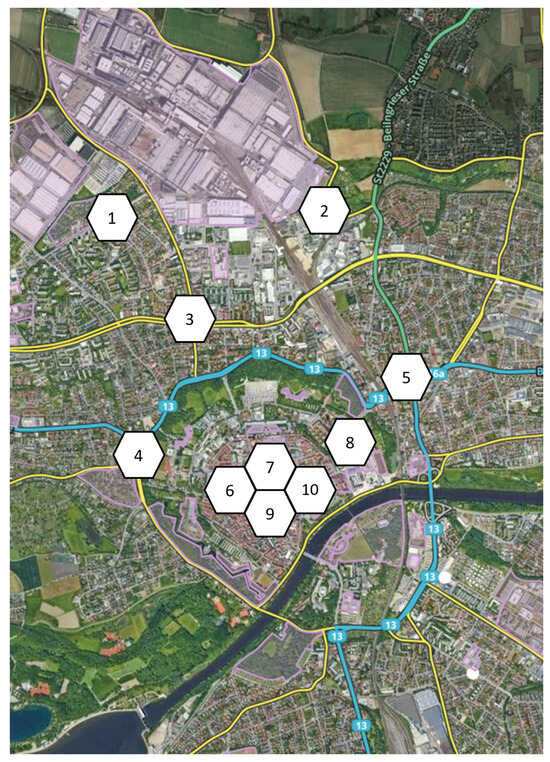
Figure 4.
5G cell sites in Ingolstadt selected for simulation.
The selected locations were as follows:
- Cells 1 and 2: Cover entrances and parking areas of the Audi factory, experiencing heavy traffic during shift changes.
- Cell 3: Located at a major intersection leading to the Audi production plant.
- Cells 4 and 5: Intersections managing traffic flow to and from the city center, consistently showing congestion according to real-time data.
- Cells 6, 7, 9, and 10: Encompass commercial areas, schools, kindergartens, and restaurants, representing diverse urban activities.
- Cell 8: Positioned at the Technische Hochschule Ingolstadt, an educational hub with approximately 6500 students and staff.
These locations were specifically chosen to ensure the simulation captures high-density vehicular traffic and its effects on 5G network performance, particularly during hours of congestion.
5.3. Experimental Scheme
The experimental design focused on three key congestion periods selected based on real traffic data to reflect times of peak vehicular activity in Ingolstadt. These periods were chosen to examine the impact of varying traffic levels and human uncertainty on network performance. Each congestion period lasted 30 min, during which two different levels of VFH application usage (5% and 10%) were tested. Table 2 outlines the simulation parameters for these hours of congestion (HC).

Table 2.
Simulation parameters during hours of congestion.
The first period (HC1), from 07:55 to 08:25, coincides with the start of the workday, during which traffic increases significantly due to commuting to schools, workplaces, and commercial areas. The second period (HC2), from 12:10 to 12:40, aligns with lunch breaks and school dismissals. The final period (HC3), from 16:30 to 17:00, corresponds with the end of the workday and a major shift change at the Audi factory. These periods were selected based on real-world congestion data, ensuring the simulations accurately reflect high-demand scenarios in urban environments.
5.4. Performance Metrics
This study employs the MMtQHU model to estimate the probability of route changes for individual drivers by incorporating an extensive array of human, social, and environmental factors. These route deviations introduce variability into the network’s traffic dynamics, which is quantified using two key performance metrics: call drop rate (CDR) and resource allocation efficiency.
5.4.1. Call Drop Rate
The CDR quantifies the percentage of communication sessions that are prematurely terminated due to insufficient network resources. It is defined as follows:
As drivers deviate from their anticipated routes, the network must dynamically adapt its resource allocation to maintain service quality. For VFH applications, maintaining a CDR below 1% is critical to ensure high-quality service. An elevated CDR indicates that the system is struggling to manage the additional uncertainty introduced by human behavior, particularly during periods of peak congestion.
5.4.2. Resource Allocation Efficiency
This metric evaluates the effectiveness of the 5G network by allocating a specific number of frequencies to each cell in response to fluctuating demand caused by human route changes.
By incorporating these metrics, the impact of human uncertainty on network performance is assessed. The results presented in the subsequent sections demonstrate how the MMtQHU model influences both CDR and resource allocation efficiency compared to traditional network resource management techniques, such as nearest rounding and ceiling rounding.
5.5. Generation of Traffic Scenarios to Analyze Human Uncertainty Effects
To thoroughly capture the effects of human uncertainty on the network, 30 unique traffic scenarios were generated for each VFH load (5% and 10%). Each simulation was repeated 15 times to account for variability in driving behaviors and network conditions. Random route deviations were introduced through a parameter , quantifying the probability of a driver deviating from the optimal route. By varying this parameter, the simulation tested a range of decision-making scenarios and their corresponding impact on network performance.
The maximum CDR was set at 1%, aligning with 5G network performance standards under high traffic conditions. This ensured that the results conformed to realistic network expectations, providing a robust dataset for evaluating the effects of human uncertainty on 5G resource management.
6. Results
This study provides a high-level evaluation model for service providers, focusing on the resources required per cell to support a maximum number of users without delving into specific underlying technologies used for optimizing operating frequencies. In our use case, a user is defined as a driver utilizing a VFH application on their cell phone, requiring a specific frequency to establish a connection with the serving cell. This abstraction, facilitated by network slicing, is pertinent for provisioning 5G services where understanding the overall infrastructure capacity to support advanced services is prioritized over detailed technical characteristics.
This section presents the results obtained from the MMtQHU model in the Ingolstadt traffic scenario, evaluating the impact of human uncertainty on resource allocation in 5G networks and on the quality of service measured through the CDR. Simulations were conducted for two vehicle load levels (5% and 10% of vehicles using VFH applications), and different frequency allocation methods, e.g., nearest integer rounding, standard rounding, and ceiling rounding, were tested during three congestion periods (HC1, HC2, and HC3).
In the simulated scenarios with optimal routes (excluding deviations due to human uncertainty), the results indicate that the CDR remained within the acceptable threshold of 1% across all congestion periods for both 5% and 10% vehicle loads. As shown in Figure 5, even during peak congestion periods, the system maintains quality of service by adhering to the CDR threshold, suggesting that allocating 12 frequencies per cell is sufficient to handle the simulated traffic levels under optimized routing conditions.
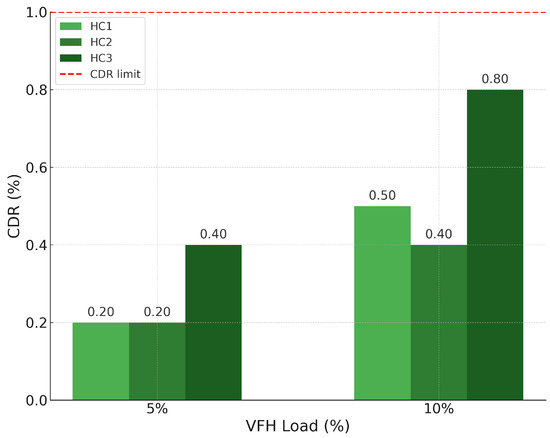
Figure 5.
CDR for optimal routing with 12 frequencies per cell during peak congestion periods.
Figure 6 illustrates the total number of frequencies allocated across the 10 evaluated cells during the three congestion periods, comparing the rounding, ceiling, and nearest methods. In all scenarios, the ceiling method consistently allocates a higher number of frequencies than the nearest method, with differences ranging from 2 to 18 additional frequencies per cell. This demonstrates that the nearest method is more conservative in resource allocation, providing an added margin of safety in high-demand situations. However, both methods result in a lower total frequency allocation compared to the ideal scenario of 12 frequencies per cell (120 total frequencies), highlighting the need for further optimization in resource management.

Figure 6.
Total frequency count by rounding method in optimal routing scenarios.
Figure 7 presents the CDR for the three peak congestion periods evaluated under VFH load levels of 5% and 10% using optimal routing. Frequencies were allocated using the nearest rounding method, chosen for its efficiency in minimizing resource usage. The results indicate that, despite the reduced frequency allocation, the CDR consistently remains below the critical 1% threshold across all congestion scenarios. This demonstrates that the nearest rounding method satisfies the required performance criteria, ensuring service reliability even under high traffic conditions with limited resource allocation. These findings underscore the method’s viability in maintaining network quality while optimizing resource utilization in 5G environments.
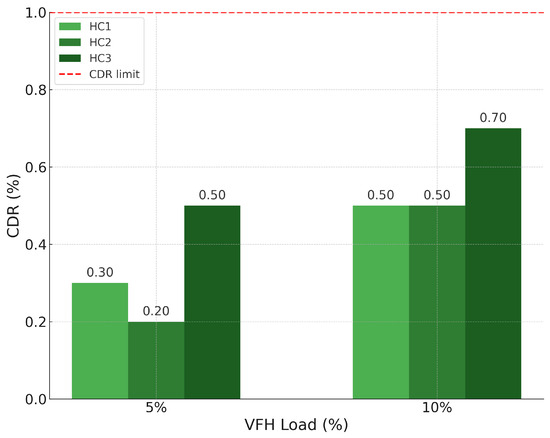
Figure 7.
CDR results with nearest rounding in optimal routing scenarios.
Figure 8 illustrates the negative impact on system performance caused by the introduction of alternative routes that deviate from the predefined paths suggested by the VFH application. This degradation is primarily attributed to insufficient resource allocation per cell, which is inadequate for addressing the dynamic demands introduced by route deviations. Notably, the HC2 period under a 5% VFH load shows less pronounced degradation, indicating marginally better adaptation to traffic variability. However, despite the application of both ceiling and nearest rounding methods for resource allocation, the CDR exceeds the established 1% limit in most scenarios. These results highlight the limitations of current resource allocation methods in maintaining service quality under unpredictable human behavior.
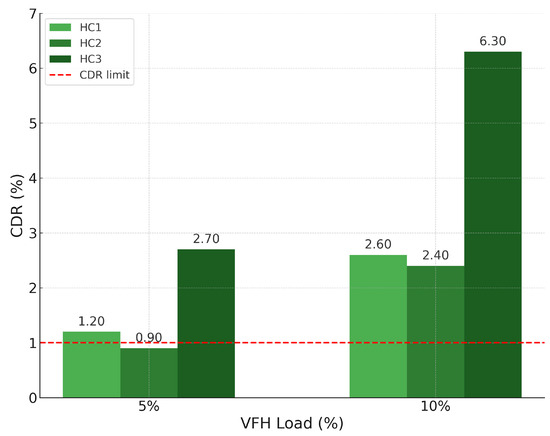
Figure 8.
CDR for alternative routing with 12 frequencies per cell during peak congestion periods.
Figure 9 depicts the distribution of frequency allocation results when considering alternative routes under a 5% VFH vehicle load across 10 selected cells during peak congestion hours. HC1 exhibits the greatest variability in frequency assignment, indicating a need to adapt to fluctuating demands and variable operating conditions commonly observed in scenarios involving high mobility, such as commercial activities or dynamic university schedules. Although HC1 shows slightly higher variability than HC2, the difference is minimal. HC2, despite sharing similar median values with HC1, displays fewer outliers and tends toward slightly higher frequency allocations in certain areas, particularly in cell C4, corresponding to mobility patterns linked to lunch hours in that area.
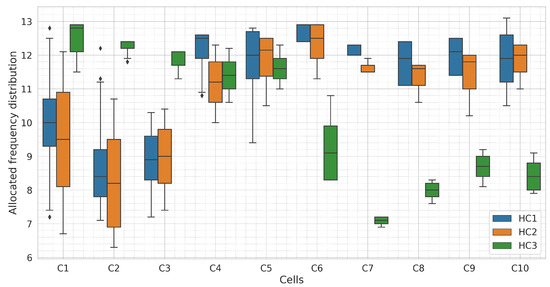
Figure 9.
Distribution of results with 5% VFH vehicle load in alternative routing scenarios.
In contrast, HC3 shows a more uniform and reduced frequency allocation, suggesting more stable network conditions and a response to more predictable demand patterns. This stability can be attributed to fixed work schedules and stricter operational constraints, reflected in lower variability. Institutional factors such as speed limits and overtaking restrictions, as incorporated in the model, also likely contribute to the more consistent behavior observed in HC3.
Figure 10 displays the distribution of frequencies assigned to the cells under a 10% VFH vehicle load scenario. Cells C1, C2, and C3 exhibit greater variability in frequency allocation during HC1, with the dispersion in C3 being particularly notable. In contrast, cell C4 shows higher variability during HC2, suggesting less predictable behavior in this area compared to HC1. HC3 generally demonstrates more stable frequency allocations, with C1 showing higher, yet more consistent, allocations.
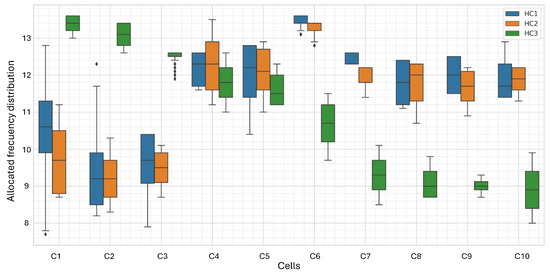
Figure 10.
Distribution of results with 10% VFH vehicle load in alternative routing scenarios.
Cells C5, C6, and C7 reveal distinct allocation patterns, with C6 experiencing significantly higher variability in HC3, while both HC1 and HC2 present more uniform distributions. In cells C8, C9, and C10, HC1 and HC2 maintain higher and more variable allocations than HC3, which exhibits a more concentrated and, in some instances, substantially lower frequency distribution, as observed in C9.
These results suggest that areas characterized by high commercial and educational activity, such as cells C3 and C6, demand more dynamic and adaptive resource management strategies, whereas more stable areas, represented by cells such as C8 and C9, reflect a more predictable and manageable frequency demand, requiring less frequent adjustment.
The simulation results obtained in this study are not limited to theoretical outcomes; rather, they provide practical insights that can be directly applied to real-world scenarios. By integrating real-time traffic data from the InTAS, actual vehicular patterns are replicated, enabling accurate predictions of traffic congestion and 5G network load fluctuations. Such preliminary studies are crucial prior to real-world implementations, as they offer valuable insights that can help avoid costs associated with potential errors by identifying and addressing issues through simulations. These results can inform traffic management strategies in urban environments, where human behavior and fluctuating demands complicate network performance. The model’s ability to simulate these variables provides a valuable framework for future applications in smart city traffic management, VFH services, and dynamic resource allocation in urban networks.
7. Discussion
The findings of this study underscore the significant challenges posed by human uncertainty in the performance of 5G-enabled CPSS. Through simulations conducted in the InTAS scenario, it was observed that variations in driver behavior introduce considerable variability in traffic dynamics, complicating the efficient allocation of network resources. These challenges are particularly pronounced in high-activity areas, where fluctuations in demand and operating conditions are frequent.
Our results indicate that the introduction of alternative routes, i.e., deviations from the predefined paths suggested by the VFH application, exacerbates resource management difficulties, leading to suboptimal network performance due to insufficient resource allocation per cell. Notably, although the HC2 period with a 5% VFH vehicle load showed a more favorable outcome, this exception does not counteract the overall trend of performance degradation. This suggests that human variability remains a critical factor that current methods struggle to mitigate effectively.
The analysis of frequency allocation methods, e.g., ceiling rounding versus nearest integer rounding, demonstrated that while both methods aim to optimize resource utilization, neither fully addresses the inefficiencies caused by human behavior variability. The nearest integer rounding method managed to keep the CDR below the 1% threshold in optimal routing scenarios, yet this came at the cost of suboptimal resource distribution when human uncertainty was introduced. This underscores the need for more advanced and adaptive strategies in 5G network management to accommodate the unpredictability of human behavior.
Furthermore, these results highlight the limitations of static resource allocation strategies in dynamic urban environments. The variability in frequency allocation requirements across different cells and congestion periods suggests that a one-size-fits-all approach is insufficient. Areas characterized by high commercial and educational activity demand more dynamic and adaptive resource management strategies, whereas more stable areas may benefit from predictable resource planning.
The practical implications of our findings are significant. By integrating real-time traffic data from InTAS, real vehicular patterns were reproduced, allowing us to accurately predict traffic congestion and load fluctuations in the 5G network. Such preliminary studies are crucial prior to real-world implementations, as they offer valuable insights that can help avoid costs associated with potential errors by identifying and addressing issues through simulations. These results can inform traffic management strategies in urban environments, where human behavior and fluctuating demands complicate network performance. The model’s ability to simulate these variables provides a valuable framework for future applications in smart city traffic management, VFH services, and dynamic resource allocation in urban networks.
Addressing human uncertainty in CPSS requires the development of more sophisticated models and adaptive resource management techniques. Incorporating real-time data analytics, machine learning, and predictive modeling could enhance the responsiveness of 5G networks to human behavior variability. Such advancements are essential for the successful deployment and operation of 5G-enabled services in complex urban environments, ultimately leading to improved service reliability and user satisfaction.
8. Conclusions
This study has significantly deepened the understanding of how human uncertainty impacts resource management within 5G-enabled CPSS. By applying the MMtQHU model to the Ingolstadt traffic scenario, the variability in driver behavior and its consequent effects on network performance, particularly during periods of high congestion, were effectively analyzed.
One of the pivotal findings is the inadequacy of traditional frequency allocation methods in fully mitigating the negative impacts of human-induced variability. This limitation underscores the pressing need for the development of more advanced, adaptive strategies, potentially integrating emerging technologies such as artificial intelligence and machine learning, to enhance the responsiveness and resilience of 5G networks in dynamic, human-influenced environments.
The insights derived from our simulations have substantial implications for real-world applications. By accurately modeling complex urban environments, the MMtQHU model provides a robust framework for predicting and addressing the challenges posed by human-driven behaviors in both traffic and network systems. These results lay a critical foundation for future implementations, where the knowledge gained can inform decision-making processes, optimize resource management, and ultimately enhance the performance and resilience of urban traffic and communication networks.
To further advance this line of research, it is recommended to validate the MMtQHU model across diverse urban environments to improve its generalizability and applicability. Additionally, incorporating real-time data streams could substantially enhance the model’s accuracy in reflecting actual conditions, enabling more effective management of human uncertainty and optimization of network performance. These efforts provide a solid foundation for future research aimed at strengthening the resilience and efficiency of 5G networks in the face of unpredictable human variability, guiding the evolution of adaptive, human-aware mechanisms in CPSS.
Author Contributions
Original draft preparation, N.A.M.; supervision, J.P., G.S.-B. and J.R.d.A.-A.; review and editing, J.P., G.S.-B. and J.R.d.A.-A. All authors have read and agreed to the published version of the manuscript.
Funding
This publication is part of the Spanish I+D+i project TRAINER-A (ref. PID2020-118011GB-C21) funded by MCIN/AEI/10.13039/501100011033 and by the aid granted by the Sinfoni project of the Cooperative University of Colombia.
Data Availability Statement
The raw data supporting the conclusions of this article will be made available by the authors on request.
Conflicts of Interest
The authors declare no conflicts of interest.
Abbreviations
The following abbreviations are used in this manuscript:
| CDR | Call Drop Rate |
| CPSS | Cyber–Physical–Social Systems |
| HC | Hour of Congestion |
| InTAS | Ingolstadt Traffic and Simulation |
| MMtQHU | Multidisciplinary Model to Quantify Human Uncertainty |
| SUMO | Simulation of Urban Mobility |
| VFH | Vehicle-for-Hire |
References
- Sobb, T.; Turnbull, B.; Moustafa, N. A Holistic Review of Cyber–Physical–Social Systems: New Directions and Opportunities. Sensors 2023, 23, 7391. [Google Scholar] [CrossRef]
- Al-Ali, R.; Bulej, L.; Kofron, J.; Bures, T. A guide to design uncertainty-aware self-adaptive components in Cyber–Physical Systems. Future Gener. Comput. Syst. 2022, 128, 466–489. [Google Scholar] [CrossRef]
- Ma, T.; Ma, T.; Ali, S.; Yue, T.; Elaasar, M. Testing self-healing cyber-physical systems under uncertainty: A fragility-oriented approach. Softw. Qual. J. 2019, 27, 615–649. [Google Scholar] [CrossRef]
- An, D.; Liu, J.; Chen, X.; Li, T.; Yin, L. A Modeling Framework of Cyber-Physical-Social Systems with Human Behavior Classification Based on Machine Learning. In Formal Methods and Software Engineering; Ait-Ameur, Y., Qin, S., Eds.; Springer: Cham, Switzerland, 2019; pp. 522–525. [Google Scholar]
- Li, T.; Li, S.; Zhang, Z.; Luo, Y.; Feng, C. Navigating uncertainty in human social decision-making: Consequences and coping strategies. Soc. Personal. Psychol. Compass 2023, 17, e12756. [Google Scholar] [CrossRef]
- Wang, G.; Su, Q.; Wang, L.; Plotkin, J.B. The evolution of social behaviors and risk preferences in settings with uncertainty. Proc. Natl. Acad. Sci. USA 2024, 121, e2406993121. [Google Scholar] [CrossRef]
- Chatterjee, A.; Reza, H. Toward Modeling and Verification of Uncertainty in Cyber-Physical Systems. In Proceedings of the 2020 IEEE International Conference on Electro Information Technology (EIT), Chicago, IL, USA, 31 July–1 August 2020; pp. 568–576. [Google Scholar]
- Patelli, E.; Alvarez, D.A.; Broggi, M.; Angelis, M.D. Uncertainty management in multidisciplinary design of critical safety systems. J. Aerosp. Inf. Syst. 2015, 12, 140–169. [Google Scholar] [CrossRef]
- Allen, J.K.; Nellippallil, A.B.; Ming, Z.; Milisavljevic-Syed, J.; Mistree, F. Designing Evolving Cyber-Physical-Social Systems: Computational Research Opportunities. J. Comput. Inf. Sci. Eng. 2023, 23, 060815. [Google Scholar] [CrossRef]
- Yang, C.; Sun, H.; Liu, J.; Kang, J.; Yin, W.; Wang, H.; Li, T. Uncertainty Modeling and Quantitative Evaluation of Cyber-physical Systems. In Proceedings of the 2021 IEEE 45th Annual Computers, Software, and Applications Conference (COMPSAC), Madrid, Spain, 12–16 July 2021; pp. 874–883. [Google Scholar]
- Zhang, M.; Selic, B.; Ali, S.; Yue, T.; Okariz, O.; Norgren, R. Understanding Uncertainty in Cyber-Physical Systems: A Conceptual Model. In Modelling Foundations and Applications; Wąsowski, A., Lönn, H., Eds.; Springer: Cham, Switzerland, 2016; pp. 247–264. [Google Scholar]
- Kortoci, P.; Zheng, L.; Joe-Wong, C.; Francesco, M.D.; Chiang, M. Fog-based Data Offloading in Urban IoT Scenarios. In Proceedings of the IEEE Conference on Computer Communications, IEEE INFOCOM 2019, Paris, France, 29 April–2 May 2019. [Google Scholar]
- de Mooij, J.; Bhattacharya, P.; Dell’Anna, D.; Dastani, M.; Logan, B.; Swarup, S. A framework for modeling human behavior in large-scale agent-based epidemic simulations. Simulation 2023, 99, 1183–1211. [Google Scholar] [CrossRef]
- Du, D.; Huang, P.; Jiang, K.; Mallet, F.; Yang, M. MARTE/pCCSL: Modeling and Refining Stochastic Behaviors of CPSs with Probabilistic Logical Clocks. In Proceedings of the 13th International Conference on Formal Aspects of Component Software, FACS 2016, Besançon, France, 19–21 October 2016. [Google Scholar]
- Alsamhi, S.H.; Kumar, S.; Hawbani, A.; Shvetsov, A.V.; Zhao, L.; Guizani, M. Synergy of Human-Centered AI and Cyber-Physical-Social Systems for Enhanced Cognitive Situation Awareness: Applications, Challenges and Opportunities. Cogn. Comput. 2024, 16, 2735–2755. [Google Scholar] [CrossRef]
- Mejia, N.A.; Perelló, J.; Santos-Boada, G.; de Almeida Amazonas, J.R. A Multidisciplinary Model to Quantify Human Uncertainty in Human-Centric Cyber-Physical-Social Systems: A 5G Application Use Case. IEEE Access 2024, 12, 63484–63503. [Google Scholar] [CrossRef]
- Wu, J.; Liu, Z.; Chen, Q. Resource allocation under stochastic uncertainty in 5G networks: A robust optimization approach. IEEE Trans. Commun. 2021, 69, 6578–6590. [Google Scholar]
- Chakraverty, S. Mathematics of Uncertainty Modeling in the Analysis of Engineering and Science Problems; IGI Global: Hershey, PA, USA, 2014; ISBN 978-1-4666-4991-0. [Google Scholar]
- Liu, B. Uncertainty Theory: A Branch of Mathematics for Modeling Human Uncertainty, 4th ed.; Springer: Berlin, Heidelberg, 2010; ISBN 978-3-642-13959-8. [Google Scholar]
- Murphy, C.; Gardoni, P.; Harris, C.E. Classification and Moral Evaluation of Uncertainties in Engineering. Soc. Sci. Res. Netw. 2010, 17, 553–570. [Google Scholar]
- Gutiérrez, R.; Ramirez, M.; Olmeda, E.; Díaz, V. An Uncertainty Model of Approximating the Analytical Solution to Stress Prediction. Metrol. Meas. Syst. 2015, XII, 429–442. [Google Scholar] [CrossRef][Green Version]
- Nan, X.; Xiaohui, F.; Weike, C. Engineering Structure Designing Method Considering Uncertainty of Human Error. Chinese Patent CN103306637B 2 October.
- Luu, Q.T.; Kerboeuf, S.; Kieffer, M. Admission Control and Resource Reservation for Prioritized Slice Requests With Guaranteed SLA Under Uncertainties. IEEE Trans. Netw. Serv. Manag. 2022, 19, 3136–3153. [Google Scholar] [CrossRef]
- Mireslami, S.; Rakai, L.; Wang, M.; Far, B.H. Dynamic Cloud Resource Allocation Considering Demand Uncertainty. IEEE Trans. Cloud Comput. 2021, 9, 981–994. [Google Scholar] [CrossRef]
- Luu, Q.T.; Kerboeuf, S.; Kieffer, M. Uncertainty-Aware Resource Provisioning for Network Slicing. IEEE Trans. Netw. Serv. Manag. 2021, 18, 79–93. [Google Scholar] [CrossRef]
- Atawia, R.; Hassanein, H.S.; Abu Ali, N.; Noureldin, A. Utilization of Stochastic Modeling for Green Predictive Video Delivery Under Network Uncertainties. IEEE Trans. Green Commun. Netw. 2018, 2, 556–569. [Google Scholar] [CrossRef]
- Xu, Y.; Hu, R.Q.; Li, G. Robust Energy-Efficient Maximization for Cognitive NOMA Networks Under Channel Uncertainties. IEEE Internet Things J. 2020, 7, 8318–8330. [Google Scholar] [CrossRef]
- Balseiro, S.; Kroer, C.; Kumar, R. Online Resource Allocation under Horizon Uncertainty. In SIGMETRICS ’23: Proceedings of the 2023 ACM SIGMETRICS/IFIP Performance International Conference on Measurement and Modeling of Computer Systems; ACM: New York, NY, USA, 2023; pp. 63–64. [Google Scholar] [CrossRef]
- Belém, C.; Kelly, M.; Steyvers, M.; Singh, S.; Smyth, P. Perceptions of Linguistic Uncertainty by Language Models and Humans. arXiv 2024, arXiv:2407.15814. [Google Scholar]
- Cha, Y.; Lee, S.W. Human Uncertainty Inference via Deterministic Ensemble Neural Networks. Proc. AAAI Conf. Artif. Intell. 2021, 35, 5877–5886. [Google Scholar] [CrossRef]
- Lobo, S.; Neumeier, S.; Fernandez, M.G.; Facchi, C. InTAS—The Ingolstadt Traffic Scenario for SUMO. In SUMO Conference Proceedings; TIB Open Publishing: Hannover, Germany, 2022; Volume 1, pp. 73–92. [Google Scholar] [CrossRef]
Disclaimer/Publisher’s Note: The statements, opinions and data contained in all publications are solely those of the individual author(s) and contributor(s) and not of MDPI and/or the editor(s). MDPI and/or the editor(s) disclaim responsibility for any injury to people or property resulting from any ideas, methods, instructions or products referred to in the content. |
© 2024 by the authors. Licensee MDPI, Basel, Switzerland. This article is an open access article distributed under the terms and conditions of the Creative Commons Attribution (CC BY) license (https://creativecommons.org/licenses/by/4.0/).